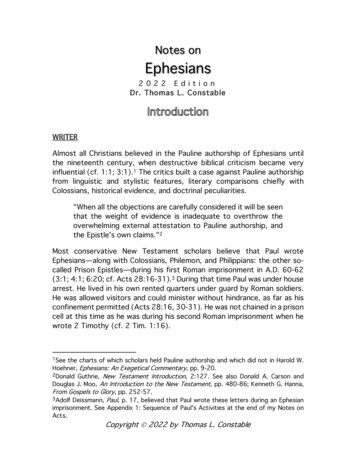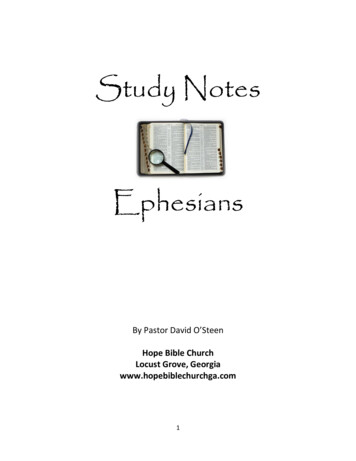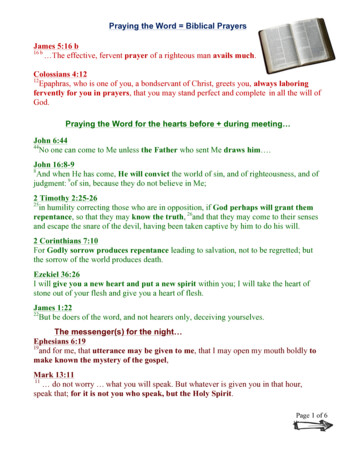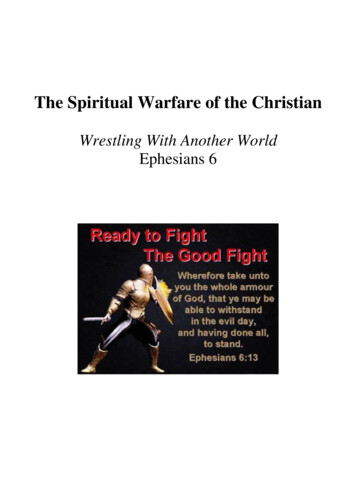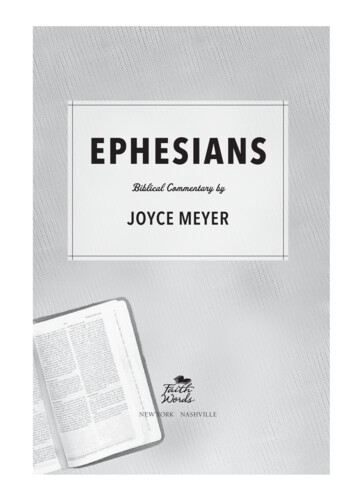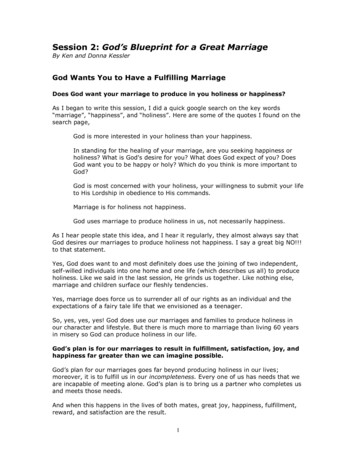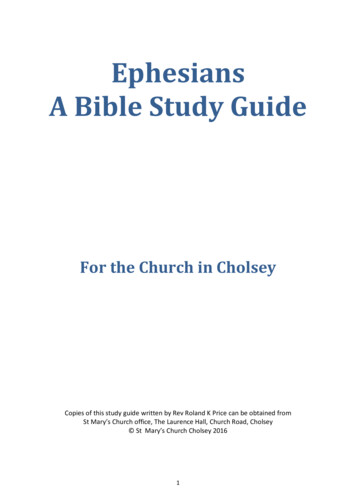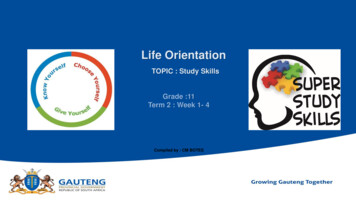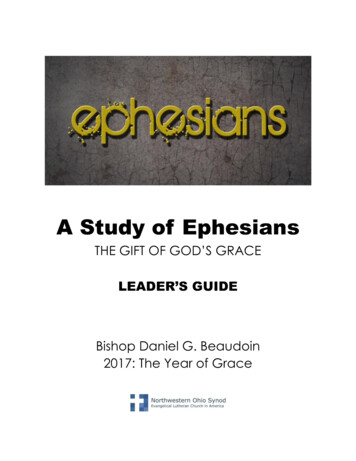
Transcription
A Study of EphesiansTHE GIFT OF GOD’S GRACELEADER’S GUIDEBishop Daniel G. Beaudoin2017: The Year of Grace
LEADER’S GUIDE CONTENTSLeader’s Guide Contentspg. 1Welcome Letterpg. 2Tips for Leaderspgs. 3-5Bible Study Resourcespg. 6Shapes and Images Keypgs. 7-8Ephesians: A Brief Introduction and Outlinepg. 9-10Ephesians Memory Versespg. 11Studies and ConversationStudy #1 Everything There Is a Season pgs. 12-16Study #2 A Purpose and a Pause for Prayerpgs. 17-21Study #3 Saved by Grace through Faithpgs. 21-25Study #4 A Purpose and a Pause for Prayer (part2)pgs. 25-29Study #5 Unity and Maturitypgs. 30-34Study #6 Live in the Lightpgs. 34-37Study #7 Live in Communitypgs. 38-41Study #8 Live Strongpg. 421 Page
Dear Friends in Christ,“For by grace you have been saved through faith, and this is not your own doing; it isthe gift of God” (Ephesians 2:8).Welcome to 2017: the Year of Grace. As we commemorate the 500th anniversary ofthe Protestant Reformation, the Northwestern Ohio Synod will celebrate the gift ofGod’s grace through worship, Bible study, book reading, and other faith practices.A few years back, I was teaching an Adult New Members Class. As I covered someof the basic theological insights of Lutheranism, one of the students asked, “Pastor, ifyou were to pick 1 word to describe Lutherans, what would that 1 word be?” I didn’thesitate. The word is “grace”.In the New Testament Letter to the Ephesians the writer focuses on the power and thegift of God’s amazing grace. One of my “go to” Bible verses is Ephesians 2:8, and thiswill serve as our memory verse for 2017: the Year of Grace. “For by grace you havebeen saved through faith, and this is not your own doing; it is the gift of God”(Ephesians 2:8). This powerful Bible verse captures both God’s intent and God’sgoodness. I would encourage you to memorize this Bible verse, so when I see you,and you recite this verse to me, you will be blessed.What follows is an 8 session Bible study on the Letter to the Ephesians. I want toencourage you to open your Bible, gather with a group of friends, get outside the 4walls of the church, and learn what God has to teach you. But, be careful. Be very,very careful, because God’s Word has the power to transform people andcommunities from who we are into the people and communities that God longs forus to be. The church in Ephesus experienced this transformation. “For once you weredarkness, but now in the Lord you are light. Live as children of light” (Ephesians 5:8).May we also experience the grace of God and the power of the Holy Spirit to renewand transform our lives and communities. God’s Word has that power.Let us pray: God of goodness and grace, as we begin the study of your Word maywe be inspired by your love and transformed by your will to be the people you longfor us to be. Hold us always in the promise of your grace. In the name of Jesus Christ.AmenBlessings,Bishop Daniel G. BeaudoinDecember 27, 2016St. John, Apostle and Evangelist2 Page
TIPS FOR LEADERS“My grace is sufficient for you, for power is made perfect in weakness”2 Corinthians 12:9You said, “Yes”. Thank you for your willingness to lead this Bible study. If this issomething new for you, no need to worry. As God once said to the Apostle Paul,“My grace is sufficient for you ”, and this is most certainly true. These lessons aredesigned to be very “user friendly” and flexible. They may be used with a varietyof groups and settings: congregational study groups, lunch studies with coworkers, gatherings with friends at a coffee shop, etc. Simply adapt the lessons toyour group and context, but I would encourage you to follow the pattern of St.Paul and lead these studies out in the “market place” (outside the 4 walls of thechurch building). You never know who might be watching, listening, wondering.These studies are intended to last around 60-75 minutes. Please note that eachlesson contains 2 to 4 Scripture passages under the Study and Conversationsection, so if time is an issue, please feel free to cover only 1 or 2 of the Scripturepassages.Now, you don’t need to be a Bible scholar to lead a Bible study. These lessons arenot designed to help you lecture, but to help you to facilitate group conversation.Below are some suggestions to assist you.*Before the Study1.Pray. Pray that God would guide you to lead faithfully. Pray for theparticipants (by name) who will gather for conversation and discussion.Ask God to open your heart and mind to hear God’s Word that it maymotivate you to a new way of thinking and being.2.Read and then slowly re-read the assigned Bible passage. Write downparticular and peculiar words and phrases. Use the notes from a StudyBible or a Bible Dictionary for insight.3.Carefully work through both the leader and student lessons. Take time tomeditate and reflect on each question. Write your responses in the spaceprovided.4.Consider ways to apply the assigned Bible passage to your life. Those whoare gathered for study will follow your lead. They will not go any deeperthan you.3 Page
During the Study1.Be sure that everyone in your group has the necessary materials: Bible,student guide, pen, or pencil. It will be helpful to have a Study Bible andBible Dictionary available for the group gathering.2.As you gather for the first time, share with the participants that thesestudies are meant to be conversations, not lectures. Encourage everyoneto participate. Refrain from putting pressure on those who may behesitant to share, especially during the initial gatherings.3.Begin each study on time and with a Bible verse. The assigned “memoryverse” is a great place to start.4.Ask for prayer requests and then lead an opening prayer. Pray for theconcerns mentioned by the participants and ask God to help the groupto understand and apply the Bible passage.5.Take a moment to review some of the highlights from last week’s lesson.6.Have someone from the group read the Introduction. Having someoneelse (besides the leader) read is a great way to cultivate confidence andraise up new leaders. A word about shapes: Each introduction includes an image or ashape. We live in an image based culture. Don’t believe me? Justtake a look at your I-Phone, computer screen, or Android device. Ihave found attaching the teachings of Jesus and Scripture to a fewbasic shapes and images help immensely with the teaching anddiscipling process. Use the shapes and images to go deeper intoScripture, the life of Jesus, and the Gospel. For a fuller explanationsee the Shapes and Images Key found on pages 7-8 of this Leader’sGuide or check out the work of Pastor Mike Breen and 3DMMinistries.7.Discuss the “Opening Reflection” questions before the Bible passage isread. The “Opening Reflection” introduces the theme of the study andhelps participants to “warm up” and begin to engage one another inconversation. Encourage as many participants as possible to respond tothe “Opening Reflection”. Be ready to get the conversation going withyour own response.8.Have a group member read the Bible passage(s) to be studied aloud.One effective method is for one participant to read the passage atnormal speed followed by another participant re-reading the passage ata slower speed. It is good to hear different voices.4 Page
9.Invite participants to read the study questions aloud and then share theirresponses.10.Tips for Leading DiscussionA.Avoid answering your own questions. When the leader does most ofthe talking, other participants will become passive and silent.B.Don’t fear the silence. Some folks need time to think through aquestion Before responding. Moments of quiet are ok. Learn tosavor them.C.Encourage multiple answers. Ask, “What do the rest of you think?”or “Does anyone have anything else to share?”D.Try to be affirming. Especially affirm participation. Never shutsomeone down. If an answer is clearly off the mark, simply ask,“Which verse led you to that response?’ Or “What do the rest of youthink?”E.During the initial sessions most answers will be directed to the leader(you). As participants become more comfortable, they will begin tointeract with one another. This interaction is the mark of a healthygroup. Cultivate it.F.Don’t shy away from controversy or conflict. It is one of the ways wegrow. If an issue cannot be resolved, don’t become frustrated.Explain that the group will move on and that God may enlighten allof you by the time you meet again.G.Periodically pause to summarize what the participants have saidabout the passage. This helps bring together the various ideas andgives continuity to the study. The goal is that folks will leave with 1 or2 “nuggets” from the study to apply in their daily lives.11.Conclude your time together by asking a participant to pray the prayer atthe end of each lesson. This is another great way to cultivate confidenceand raise up new leaders.12.End on time.*adapted from Bible Studies for Everyone by N.T. Wright5 Page
BIBLE STUDY RESOURCESStudy BiblesLutheran Study Bible - NRSV (2009) Published by Augsburg FortressHarper Collins Study Bible – NRSV (2006) Published by Harper OneNIV Zondervan Study Bible – NIV (2015) Published by ZondervanESV Study Bible – ESV (2008) Published by CrosswayBible Dictionary / HandbookHarper Collins Bible Dictionary (2011) Published by Harper OneHalley’s Bible Handbook (2014) Published by ZondervanBible AtlasesOxford Bible Atlas (2009) Published by Oxford University PressThe Student Bible Atlas (2005) Published by Augsburg FortressZondervan Atlas of the Bible (2010) Published by ZondervanCommentariesEphesians by Pheme Perkins (1997) Published by Abingdon PressPaul: The Prison Letters by N.T. Wright (2004) Published by Westminster John KnoxPressEphesians (2 volumes) by Markus Barth (1974) Published by Doubleday andCompanyOtherRose Book of Bible Charts, Maps and Timelines (2015) Published by RoseLuther’s Small Catechism (2016) Published by Augsburg FortressLuther’s Small Catechism with Explanation (2005) Published by Concordia6 Page
SHAPES AND IMAGES KEYFatherAscending Triangle: This Is Who God IsGod the FatherGod the SonGod the Holy SpiritHoly SpiritSonFaithWorks.Semi-Circle: Rhythms of LifeRest and LaborTime On and Time OutFaith and WorksInOutDescending Triangle: This Is What God DoesGod Comes Down.God Gathers Us In.God Sends Us Out.God sends us out.DownPentagon: Gifts for the ChurchAApostles: Extend the Gospel of Jesus ChristTPProphets: Know God’s Will for the Christian CommunityEvangelists: Recruit Others to the Ministry and MissionPastors: Protect and Nurture the Christian CommunityPETeachers: Understand and Explain God’s Truth7 Page
PrayerPrayer: Martin Luther was once asked by his barber, “Dr.Luther, how do you pray?” In 1535, Luther wrote, A SimpleWay to Pray, for a Good Friend. Here Luther recommendsprayer as a daily routine. For many people, the acronymT.R.I.P. has proven helpful for daily prayer.Thanks: For whom / for what am I thankful?Regret: What has caused me regret?Intercession: For whom / for what do I need to pray?Purpose: What action is God calling me to take today?Live in the LightThe Light: In Ephesians 5:8, Christians are called to live aschildren of light. As followers of Jesus, the light of Godshines in us and through us. Yes, we are saved bygrace, and not by works (Ephesians 2:8-9); but the waywe live our lives is important. Some theologians arguethat we are saved by grace through faith for goodworks (Ephesians 2:10). The lit candle will serve as areminder that we are to live in the light of Christ.Table of Duties: For Christians, the death and resurrectionof Jesus Christ frees us from having to impress God withwho we are and what we do. By faith in God’s promise inChrist, we are free to serve our neighbor in our everydaylives. Martin Luther called daily life a “holy order andestate”, and used Scripture passages in what hastraditionally been called a “Table of Duties” to show howChristians should live in family and society.8 Page
EPHESIANS: A BRIEF INTRODUCTION AND OUTLINEDuring the 1st century, Ephesus was a major port city in the Roman province ofAsia (modern day Turkey). With an estimated population of between 200,000 250,000 people, Ephesus ranked with other great urban centers of the RomanEmpire including: Carthage (300,000), Antioch (400,000), Alexandria (500,000),and Rome (1,000,000). Ephesus was a cross roads of commerce; a true “eastmeets west” city. Trade goods that arrived by caravan from the east wereshipped down the Cayster River, into the Aegean Sea, and out to otherMediterranean seaports.Ephesus was a wealthy city with impressive civic and religious monuments. Widecity streets, huge public structures, and luxurious private homes were built toimpress. North of the city was the huge Temple of Artemis, one of the sevenwonders of the ancient world. There was a large theater that could seat 25,000people, an agora (marketplace), public baths, a library, and many other smalltemples.We first encounter the city of Ephesus in the Book of Acts. In Acts 18:18-21, St.Paul ends his second missionary journey (est. 49-52 C.E.) with a very short stop inEphesus. He is joined by Priscilla and Aquilla. After a brief stay, Paul departs fromEphesus with a promise to return, “if it is God’s will.” On his third missionaryjourney (est. 52-57 C.E.), Paul returns to Ephesus and remains there for almost 3years (Acts 20:31). While in Ephesus, Paul established a network of “housechurches”. This network eventually spread the “Jesus movement” throughoutthe Roman province of Asia. Acts chapters 19-20 details Paul’s ministry inEphesus.The Letter to the Ephesians has historically been attributed to the Apostle Paul(1:1; 3:1). However, the literary style and the distinct use of “non-Pauline” wordscause some Bible scholars to question Paul’s authorship. Many scholars attributethe writing of Ephesians to one of Paul’s students (disciples). Other scholars takea different approach and argue that the Letter to the Ephesians was written byPaul as a circular letter to be distributed to several Christian churches in theRoman province of Asia. In fact, in some of the earliest and most importantmanuscripts the words “in Ephesus” (1:1) are missing. This argument affirms therather impersonal nature of the letter and the lack of personal greetings thatmark so many of Paul’s other letters. So, Ephesians is most likely a circular letter ofPaul’s sent to several churches in western Asia Minor (including the Church inEphesus).The Letter to the Ephesians follows the standard pattern of ancient letter writing(see Outline of Ephesians). There is an opening (1:1-2), a body (2:1-6:20), and a9 Page
closing (6:21-24). The body of the letter is divided into two parts: theologicalreflection (2:1-3:21) and ethical exhortation (4:1-6:20). Unique features include alengthy benediction (1:3-14) and two prayers (1:15-23 and 3:14-21). Ephesians1:3-14 is one entire sentence in Greek.Important themes that we will encounter in the Letter to the Ephesians include:the gift of God’s grace, the call to unity; the cosmic Christ, and the universalChurch.OUTLINE OF EPHESIANS1.Greeting (1:1-2)2.God’s Purpose (1:3-14) 1:10 is a key verse “as a plan for the fullness of time, [God will]gather up all things in him, things in heaven and things onearth”.3.Prayer Pause A (1:15-23)4.God Has a Purpose (2:1-3:21)a.Saved by Grace (2:1-10)b.One in Christ A (2:11-22)c.Paul Proclaims God’s Purpose (3:1-13)d.Prayer Pause B (3:14-21)5.God Has a People (4:1-6:20)a.One in Christ B (4:1-6)b.God’s People Live (and Lead) with their Gifts (4:7-16)c.God’s People Live in the Light (4:17-5:20)d.God’s People Live in Community (5:21-6:9)1.)Husbands and Wives (5:21-33)2.)Children and Parents (6:1-4)3.)Slaves and Masters (6:5-9)e.God’s People Live Strong (6:10-20)6.Benediction (6:21-24)10 P a g e
EPHESIANS MEMORY VERSESStudy 1Ephesians 2:8 “For by grace you have been saved through faith, and this is notyour own doing; it is the gift of God”.Study 2Ephesians 1:3 “Blessed be the God and Father of our Lord Jesus Christ, who hasblessed us in Christ with every spiritual blessing in the heavenly places.”Study 3Ephesians 2:8-10 “For by grace you have been saved through faith, and this isnot your own doing; it is the gift of God— not the result of works, so that no onemay boast. For we are what he has made us, created in Christ Jesus for goodworks, which God prepared beforehand to be our way of life”.Study 4Ephesians 3:14 “For this reason I bow my knees before the Father,”Study 5Ephesians 4:11-12 “The gifts he gave were that some would be apostles, someprophets, some evangelists, some pastors and teachers, to equip the saints forthe work of ministry, for building up the body of Christ,”Study 6Ephesians 5:8 “For once you were darkness, but now in the Lord you are light.Live as children of light- “Study 7Ephesians 6:10 “Finally, be strong in the Lord and in the strength of his power.”11 P a g e
LEADER STUDY #1: FOR EVERYTHING THERE IS A SEASON 1.Read the Opening Scripture Passage: Ephesians 2:82.Take Prayer Requests and Lead an Opening Prayer3.Offer a Welcome and Lead Introductions4.Offer Any Announcements that Are Pertinent to the Group5.Introduction to the Study (encourage a participant to read)In the Book of Ecclesiastes 3:1 we read, “For everything there is a season ”. As Iprepare this study, we are experiencing a typical Northwestern Ohio winter. Wehad a white Christmas on December 25, which was followed by a 61 degreeDecember 26. Many of our neighbors delighted in the gift of an unseasonablywarm day and took down their outdoor Christmas decorations. Living in theMidwest, we get this whole notion of seasons. We understand that seasons bringchange.People experience different seasons in life. Rachel and I are slowly learning whatit means to be empty nesters, as our 2 oldest children have moved out of ourhome. Some of you may be looking forward to a new season of independenceas you prepare for graduation or marriage. Others may be facing a moredifficult season as you deal with aging parents, ill health, and limited mobility.Churches also experience different seasons. As the Bishop of the NorthwesternOhio Synod, I am invited to participate in congregational anniversaries. St.Martin’s Lutheran Church in Archbold, Ohio recently celebrated their 150 thanniversary. In their Fellowship Hall, they had an awesome display thathighlighted different seasons in the history of their congregation.The Church in Ephesus also experienced several different seasons. In Acts 19, theEphesians experienced a season filled with excitement and potential as theApostle Paul started his 3rd missionary journey (est. 52-57 C.E.) in the city ofEphesus with a bang! Baptisms, healings, Gospel preaching, exorcisms, bonfires,and a riot make for quite a season!In Acts 20:13-38, there is quite a different season, as Paul bids farewell to theleaders of the Church in Ephesus. In Acts 20:37-38, we read, “There was muchweeping among them all; they embraced Paul and kissed him, grievingespecially because of what he had said, that they would not see him again.Then they brought him to the ship.” Sometimes our seasons involve tears andpainful goodbyes.12 P a g e
In Revelation 2:1-7, there is a yet another season for the Church in Ephesus, asthe Exalted Jesus offers comfort and challenge. Over 40 years have passedsince St. Paul began his missionary work among the people of Ephesus, andthings have changed. As many congregations in North America haveexperienced, the Church in Ephesus is no longer what it once was. Here Jesuspraises the Ephesians for their toil, patience, and endurance. But then Jesusadmonishes them, “But I have this against you, that you have abandoned thelove you had at first. Remember then from what you have fallen; repent, and dothe works you did at first” (Revelation 2:4-5). Sometimes our seasons arereminders of what we once were. And sometimes our seasons are reminders ofwhat we have the potential to be.6.7.Opening Reflection QuestionsA.What is your favorite season? Why?B.How would you describe the season of life you are currentlyexperiencing?Study and ConversationA.The Season of Spring: The Church in Ephesus Springs into Action1.Read Acts 19:1-7, 8-10, 11-20, 21-41 (encourage differentreaders)2.What were some of the signs that the Church in Ephesus wasspringing into action? (see below)a.19:6-7 - The Holy Spirit allowed 12 disciples to speak intongues and prophesyb.19:9-10 - Paul preached in a lecture hall for 2 years, andall the residents of Asia, both Jews and Greeks, heardthe Word of the Lordc.19:11 - God performed miracles through Pauld.19:12 - People with diseases were healed and evil spiritswere driven oute.19:19 - Books of magic were publicly burnedf.19:20 - The Word of the Lord grew mightily andprevailedg.19:28-29 - A riot breaks outh.19:38-41 - A riot is quelled3.When you consider the springtime of your life, where wereyou and what was your experience?13 P a g e
B.4.What would a springtime in the life of a congregation looklike? Describe it.5.Have you ever experienced a springtime in yourcongregation? Describe that time.6.When you’re in the season of springtime how might youprepare for the seasons that are to come?The Season of Fall: Forlorn and Farewell1.Read Acts 20:17-382.Reflect on Paul’s season of forlorn and farewell?a.Where is Paul going? (20:22 to Jerusalem)b.What will Paul face in Jerusalem? (20:23 prison andpersecution)c.Will the Ephesian elders ever see Paul again? (20:25 no)d.How long was Paul with them? (20:31 three years)e.Why does Jesus say. “It is more blessed to give than toreceive” (20:35). Is this true? Have you everexperienced this? Describe that experience.f.How did Paul and the Ephesian elders say goodbye toone another?1.)20:36 - they pray together2.)20:37a - they weep together3.)20:37b - they embrace and kiss4.)20:38 c - they walk to the ship together3.When have you experienced a season of forlorn andfarewell? How did you say goodbye? How did you fail to saygoodbye?4.What does a season of forlorn and farewell look like in acongregation?14 P a g e
5.C.D.How do you find the hope and courage to move forwardwhen you are experiencing a season of forlorn and farewell?The Season of Winter: Faithful and Frozen1.Read Revelation 2:1-72.For what does the exalted Jesus praise the Church inEphesus?a.2:2 - for their toil and patient enduranceb.2:2 - they will not tolerate evildoers and they test falseapostlesc.2:3 - they endure with great patience and have notgrown wearyd.2:6 - they hate the work of the Nicolaitans3.For what does the exalted Jesus critique the Church inEphesus?a.2:4 - they have abandoned the love they had at firstb.2:5 - they have fallen from what they once were4.What are some ways people get stuck and frozen?5.How do churches get stuck and frozen?6.How does one go about getting unstuck and unfrozen?The Season of Summer: Sunshine and Salutations1.Read Ephesians 1:1-2a.This letter opening is called the salutation.b.Ancient salutations usually have 3 parts1.)2.)3.)Name of sender: Paul, an apostle.Name of recipients: God’s holy people inEphesusA short blessing: “Grace and peace to you fromGod ”15 P a g e
2.Why does Paul begin with his credentials?3.As a group try to come up with 7 facts about the life of St.Paul.4.When is it good to know someone’s credentials? (surgeon,dentist, tax accountant)5.How does Paul describe the people of Ephesus? (full ofsunshine: holy and faithful) Is this an accurate descriptionbased upon the church folks you know? (probably not)6.What might be another way to describe followers of Jesus?(cloudy with a chance for sudden storms or simultaneouslysinner and saint)8.Closing Question: What is your one take away from today’s study? Whommight you share this “take away” with this week?9.Homework10.A.Read Ephesians Chapter 1B.Memory Verse Ephesians 2:8Closing Prayer (led by participant): Good and gracious God, we give youthanks for the seasons in our lives. Lead us to be steadfast in our seasonsof discontent and grateful for our seasons of delight. Be with those we loveand with those who are in need. Bless us to be the people you long for usto be in and out of season. In the name of Jesus. Amen16 P a g e
LEADER STUDY #2: A PURPOSE AND A PAUSE FOR PRAYER1.Read the Opening Scripture Passage: Ephesians 1:32.Take Prayer Requests and Lead an Opening Prayer3.Offer a Welcome and Lead Introductions4.Offer Any Announcements that Are Pertinent to the Group5.Review: Any questions / comments from last week’s study?6.Memory Verse Recitation Ephesians 2:8 (ask for volunteers)7.Introduction to the Study (encourage a participant to read)FatherAscending Triangle: This Is Who God IsGod the FatherGod the SonGod the Holy SpiritHoly SpiritSonThe first shape that we encounter in our Ephesians study is the AscendingTriangle. This is where we always begin as Christians. Let’s start at the top of theAscending Triangle with the Father; then trace your finger down to the Son; thentrace your finger over to the Holy Spirit; finally back to the Father. Then repeat.This Ascending Triangle will serve as our visible reminder of who God is. ForChristians God is Father, Son, and Holy Spirit. 1 God in 3 persons. God is God.Jesus is God. The Holy Spirit is God. What the Father is, the Son is, and so is theHoly Spirit.The Apostles’ Creed is another great reminder of who God is. Let’s recite ittogether:I believe in God, the Father almighty, creator of heaven and earth.I believe in Jesus Christ, God’s only Son, our Lord, who was conceived by theHoly Spirit, born of the virgin Mary, suffered under Pontius Pilate, was crucified,died, and was buried; he descended to the dead. On the third day he rose17 P a g e
again; he ascended into heaven, he is seated at the right hand of the Father,and he will come to judge the living and the dead.I believe in the Holy Spirit, the holy catholic church, the communion of saints, theforgiveness of sins, the resurrection of the body, and the life everlasting. Amen.Did you notice that the Apostles’ Creed has 3 paragraphs? Did you notice thatthe Ascending Triangle has 3 points? 1 for God the Father. 1 for God the Son. 1for God the Holy Spirit. It is important for us to begin with who God is, and this iswhere Paul also begins in Ephesians chapter 1.After Paul opens the Letter to the Ephesians with credentials, recipients, and agreeting (1:1-2), he turns to God. Ephesians 1:3-14 is actually 1 long sentence inthe original Greek. Bible scholars call this section a “doxology” or blessing. Asyou read through this passage, notice some of the language Paul uses for God:God the Father (1:3); Lord Jesus Christ (1:3); Holy Spirit (1:13).Also, note that this doxology (1:3-14) is composed of 3 sections of 3 blessings(there seem to be 3’s everywhere we turn!). These blessings are based on thework of the triune God. 1:4-6 celebrates the fact that God chooses God’speople by grace. 1:7-12 celebrates God’s redemptive purpose through JesusChrist for us and the world. 1:10 is a key verse as God promises to gather allthings in him. 1:13-14 celebrates our sealing in the Holy Spirit. Each of thesesections conclude with a mini-refrain that praises God’s glory (1:6, 12, 14).After the doxology (1:3-14), Paul pauses to pray a prayer of thanksgiving (1:1523). During our study, we’ll learn about the T.R.I.P. form of prayer and begin usingit as a model for daily prayer.8.9.Opening Reflection QuestionsA.Can you think of a time in your life when you felt like you didn’tbelong? DescribeB.Can you think of a time in your life when you felt valued and a partof something? Describe.Study and ConversationA.God’s Purpose: Chosen by Grace1.Read Ephesians 1:3-62.What word or phrase from this reading struck you? Why?18 P a g e
B.C.3.What has God done for us through Jesus Christ? (1:4 chose usin Christ)4.What is special about the fact that God chooses us as Hispeople? How might that differ from us choosing God? SeeJohn 15:165.We are not chosen by God for our own sake. We are chosenby God (by grace) for a purpose. In what ways might Godwant to bless others through you? In what ways might Godwant to bless others through your church?God’s Purpose: All Things Redeemed1.Read Ephesians 1:7-122.What word or phrase from this reading struck you? Why3.What is one of the blessings we receive in Jesus (see vs. 7)? The forgiveness of our trespasses (sins)4.In 1:8, Paul uses the word “lavish” to describe the blessings wereceive in Jesus. This is a word we seldom use. Break intoteams of 2 and come up with a sentence using the word“lavish”.5.What is God’s big plan / purpose? (see vs. 10) God promises to gather all things in him, things inheaven and things on earth.6.Are there any places where you see God’s big plan / purposecurrently unfolding? How might you or your church join Godin this work?God’s Purpose: Sealed with a Promise1.Read Ephesians 1:13-1419 P a g e
D.2.When are we marked with the seal of the Holy Spirit?3.What do you know about your baptism?a.Where?b.When?c.Pastor’s name?d.Who was present?e.God parents?4.How does our baptism remind us that we belong?5.In what ways do you bring praise to God’s glory (1:14)?6.In what ways does your church bring praise to God’s glory(1:14)?A Pause for Prayer1.Read Ephesians 1:15-232.Read through the T.R.I.P. prayer modelPrayer: Martin Luther was once asked by his barber, “Dr.Luther, how do you pray?” In 1535, Luther wrote A Simple Wayto Pray, for a Good Friend. Here Luther recommends prayer asa daily routine. For many people, the acronym T.R.I.P. hasproven helpful for daily prayer.Thanks: For whom / for what am I thankful?Regret: What has caused me regret?Intercession: For whom / for what do I need to pray?Purpose: What action is God calling me to take today?3.Can you find any places in Paul’s prayer (1:15-23) where heoffers:a.Thanks (vs. 16)b.Intercession (vss. 17-19)20 P a g e
4.Compose a simple 4 sentence prayer using the T.
Bible Study Resources pg. 6 Shapes and Images Key pgs. 7-8 Ephesians: A Brief Introduction and Outline pg. 9-10 . As God once said to the Apostle Paul, “My grace is sufficient for you ”, and this is most certainly true. These lessons are designed to be very “use
